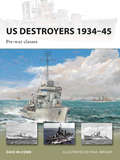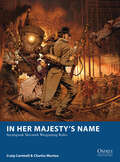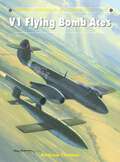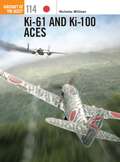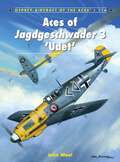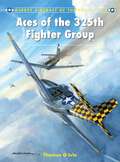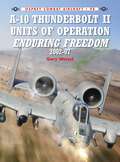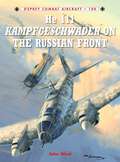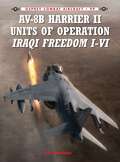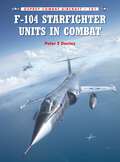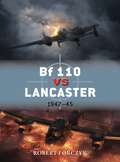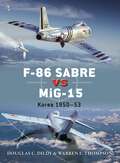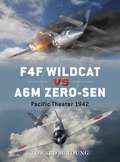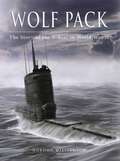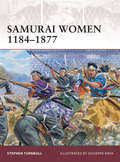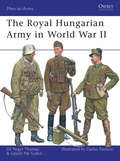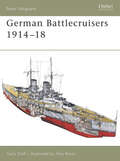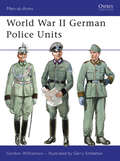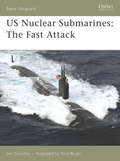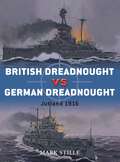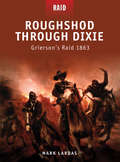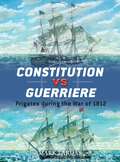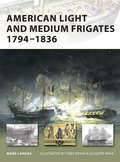- Table View
- List View
US Destroyers 19340-45: Pre-war classes
by Paul Wright Dave MccombSince the beginning of the 20th century, destroyers have been all-purpose ships, indispensable in roles large and small - from delivering the mail at sea to screening other vessels and, where larger ships were not present, forming the front line in battle. This title details the 169 ships of ten classes introduced in the 1930s: early 1,500-tonners and 1,850-ton destroyer leaders designed to conform to the 1930 London Naval Treaty, plus the successor 1,570-ton Sims class and 1,620- and 1,630-ton Benson and Gleaves classes. In wartime, most 1,500-tonners and leaders initially saw front line duty in the Pacific but were relegated to secondary assignments as newer vessels arrived; while the later 1,620- and 1,630-tonners became the standard destroyers of the Atlantic War. This volume reveals the fascinating design story behind these pioneering classes - from the constraints of peacetime treaties to advances in propulsion engineering, and wartime modifications. With an operational overview of their service and tables listing all ships by class, builder, and initial squadron, this is the definitive guide to the pre-war US destroyer classes.
In Her Majesty's Name
by Fabien Lascombe Craig CartmellIt is 1895 and the world is in turmoil. In the decades to come, historians will reflect upon the cause of this state of affairs and many will point squarely at Charles Babbage. The perfection of first his Difference Engine, and then his Analytical Engine, gave the new scientific establishment in the Great Powers the tool they had so long needed in order to make a dramatic leap forward. The ability to make huge and repeatable sets of complex calculations revolutionized the world.Within twenty years came the 'invention' of Cavorite, the perfection of miniaturized steam engines, electric light and motors, Radium Bricks, Arc weapons, Hydrogen and Helium Dirigibles, Road Trains, Calculating Artillery Engines, Sea and Land Dreadnoughts - the list is almost endless. Nothing is impossible when the wealth of a Great Power is coupled to the unlimited imagination of educated men of science and their engineers.The one thing that all these marvellous advances have not brought is peace. Every Great Power has been jostling its neighbours for resources and more importantly, the latest technology. None can afford to stand still and allow its neighbours to advance their science and engineering unmolested. If they do, they risk being overwhelmed as the French were in 1861 by the Prussians' mobile Calculating Artillery Engines, or as the Union was the year after that, with their ports put to the flame and successfully blockaded by the Confederacy's Armoured Sea Dreadnoughts.Some nations have also been tapping into older, more sinister powers, in order to produce an unholy combination of the mystical and the mechanical, such as the Prussian Todt-truppen.Although there have been relatively few open conflicts between the Great Powers, a state of undeclared and secret war exists between them all. This is where the Adventuring Companies come in. These are the deniable clandestine agents of the Great Powers (and of other globe-spanning organizations). They act in the shadows pitting their skills, their wits and the latest technologies against each other, to obtain the latest scientific formula, artefact or other vital component.Small groups of highly skilled and specialized operatives are brought together for each mission under the command of a trusted 'Captain'. In Great Britain they work out of the Explorers' Club in London. In Prussia their patron is the highly secretive Thule Society. In the USA they are mostly sponsored by the Secret Service. There are similar organizations in each of the Great Powers. They each have the choice of their nation's latest arms, armour and other equipment with which to perform their missions.
V1 Flying Bomb Aces
by Chris Davey Andrew ThomasShortly after the Allied landings in France the Germans unleashed the first of their so-called 'revenge weapons' against London, the V1 flying bomb. Launched from specially constructed sites in northern France, the fast, small, pulse-jet powered and pilotless aircraft were aimed at London with the intent of destroying civilian morale in order to force the British government to negotiate a peace. This dangerous new threat drew an immediate response, and the Air Defence of Great Britain (as Fighter Command had been temporarily renamed) established layers of defence that included a gun line and balloon barrage. The main element, however, were standing patrols by the first fighter wings of the highest performance fighters available - the new Tempest V and Griffon-powered Spitfire XIV. Other types were allocated too, most notably the Polish Mustang wing, while night defence was left in the capable hands of several dedicated Mosquito squadrons. Although pilotless, the V1 was no easy foe thanks to its speed, powerful warhead and sheer unpredictability. It required a high degree of flying skill and cool courage to bring one down, for if the pilot fired at too close a range the missile's warhead could explode, with catastrophic results for the chasing fighter. Many hundreds of V1s were fired throughout the summer of 1944, giving pilots plenty of opportunity to achieve five or more successes to become a V1 ace. Many already established aces also made claims against this new weapon. In total, 154 pilots became V1 aces, 25 of whom were also aces against manned aircraft. In addition, a further 35 RAF and nine USAAF aces also made some claims against V1s.
Ki-61 and Ki-100 Aces
by Nicholas MillmanThis is the story of the elite Japanese Army Air force (JAAF) aces that flew the Kawasaki Ki-61 Hien (Swallow), and the Ki-100 Goshikisen in the Pacific Theatre of World War 2. The former, codenamed 'Tony' by the allies, was a technically excellent aircraft, possessing power, stability and a good rate of climb - differing radically from the usual Japanese philosophy of building light, ultra-manoeuvrable fighters. Its pilots soon realised, however, that the type was plagued by a number of dangerous mechanical issues. Then as the war moved relentlessly closer to Japan's doorstep, a desperate, expedient innovation to the Ki-61 airframe by fitting it with a radial instead of inline engine resulted in one of the finest fighters of World War 2 - the Ki-100. This book uses the latest findings to provide a gripping account of some of the most remarkable and hard-pressed fighter pilots of the war. It reveals how these men, unlike so many of their unfortunate late-war colleagues, could surprise Allied aircraft in high-performance fighters and claim successes in the face of enormous odds.
Aces of Jagdgeschwader 3 'Udet'
by John WealIn Me-109s and FW-190s from the Battle of Britain to Stalingrad, Kursk, Normandy, the Battle of the Bulge, and Berlin, German aces from Jagdgeschwader 3 racked up a stunning aerial record.Jagdgeschwader 3 may not have the same immediate resonance as some of the more famous Luftwaffe fighter units, such Jagdgeschwader 2 'Richthofen', but it is arguably the archetypal German fighter formation of World War 2. Not only did it participate in every campaign fought by the Luftwaffe (with the exceptions of Poland and Norway), it flew every major variant of the two legendary German wartime fighters, the Messerschmitt Bf 109 and the Focke-Wulf Fw 190 - starting with the Bf 109E in 1939 and ending with the Fw 190D-9 'Long-nose' in 1945. And, during the course of the hostilities, it numbered among its ranks more than 70 Knight's Cross winners (a total exceeded by only one other Jagdgeschwader). The wealth and variety of detail afforded by such a background - which includes the historic battles of Britain, Stalingrad, Kursk, Normandy, the Ardennes and Berlin - provides an ideal framework upon which to portray the multitude of stories, exploits and ultimate fates of the many aces themselves, from the now unknown trio who achieved their first five kills during the Blitzkrieg in France in the late spring/early summer of 1940 to the nearly two-dozen highly acclaimed and lauded 'centurions' who flew with JG 3.
Aces of the 325th Fighter Group
by Chris Davey Tom IvieAmerican pilots flew P-40 Warhawk, P-47 Thunderbolt, and P-51 Mustang fighters over Noth Africa, Sicily, and Italy in the World War II Mediterranean Theater of Operations as part of the 325th Fighter Group. The 325th FG was activated under General Order number 50 on 30 July 1942 and set up training operations at Theodore F Greene Field in Providence, Rhode Island. By mid-December 1942 the group was considered ready for combat and the alert for overseas duty arrived on 2 January 1943. The pilots and their P-40s departed on the carrier USS Ranger on 8 January and flew their aircraft off the vessel into Cazes airfield, near Casablanca, on 19 January 1943. After the remainder of the personnel arrived in late February, the group prepared for combat, and finally flew its first mission on 17 April 1943 as part of the Twelfth Air Force. During the next four months it participated in the North African campaign, and operations against enemy-held islands in the Mediterranean Sea. By the end of the Sicilian campaign on 17 August the 325th FG had scored 128 aerial victories, been the first P-40 unit to deliver 1000-lb bombs against enemy targets, and had escorted 1100 bombers without losing a single one of them to enemy action. In September 1943 the 325th began its conversion to the P-47 Thunderbolt and in late December headed for its new base in Italy. During the next six months the 325th flew escort missions over Italy and the Balkan countries as part of the Fifteenth Air Force. During its P-47 period the 325th's pilots claimed 153 aerial victories and established itself as a very aggressive escort group. In May 1944 the 325th began converting to the P-51 Mustang, which it flew with great success for the remainder of the war. Thirteen of its 27 aces achieved this status while flying the Mustang. By VE Day the 325th FG had destroyed 537 enemy aircraft in aerial combat and 281 on the ground, as well as numerous ground targets such as locomotives, trucks etc. The group was awarded two Distinguished Unit Citations and its pilots earned numerous medals, including four Distinguished Service Crosses, for individual bravery in combat. The cost was high, however, as 148 pilots were lost in action - being killed or becoming PoWs.
A-10 Thunderbolt II Units of Operation Enduring Freedom 2002-07
by Jim Laurier Gary WetzelIn the early 1970s, the USAF, still fresh in the mire of the Vietnam War, began the search for a more effective aircraft to conduct the CAS mission. With aircraft losses climbing, the need for an aircraft that could withstand punishment as well as deliver it was unmistakable. Looking at past experience in Southeast Asia as well as the present and future threat in Western Europe of a numerically superior Soviet Army, the USAF demanded that the new aircraft be built around a 30 mm cannon. Fairchild Republic won the resulting A-X competition in 1973 and General Electric was chosen the following year to build the jet's GAU-8 30 mm main gun. Some 715 A-10s were subsequently built between 1975 and 1984. The A-10 was never a favourite amongst the USAF's senior staff, and prior to Iraq's invasion of Kuwait in 1990 they had attempted to transfer the aircraft to the US Army and Marine Corps. Everything changed when Operation Desert Storm began, as the A-10 quickly showed what it was capable of. Reprieved from premature retirement, the A-10 would see combat in the Balkans during the mid-1990s and over Iraq in Operations Northern Watch and Southern Watch until Operation Iraqi Freedom began in 2003. Following the 11 September 2001 attacks in the United States, the Bush administration responded with the instigation of Operation Enduring Freedom in Afghanistan in October 2001. A-10 aircraft first entered the fray during Operation Anaconda in March 2002, flying first from an airfield in Pakistan and then from Bagram AB in Afghanistan. During Anaconda four A-10s flying from Pakistan provided 21 straight hours of FAC (A)/CAS coverage. Since then the flexibility of the A-10 has persisted, with units moving through airfields in Afghanistan under AEF deployments. This ongoing commitment has seen active duty, Reserve and Air National Guard squadrons rotating through Bagram and Kandahar airfields in support of Coalition forces in-theatre. The premier CAS aircraft in Afghanistan, the once disposable A-10 has become indispensable. With new upgrades, the 'digital' A-10C has seen its arsenal expanded to include the latest generation of ordnance. The untold story of the A-10 in Enduring Freedom will be explored and presented as never before through first hand interviews and photography from those involved, along with official military achieves. This title is the first of three planned covering the combat experience of the USAF's A-10 Thunderbolt II units. Follow-on volumes will examine the role of the Warthog during Operation Desert Storm and Operation Iraqi Freedom.
He 111 Kampfgeschwader on the Russian Front
by John WealThe twin-engined He 111 was the mainstay of the Luftwaffe's bomber arm at the start of World War 2. This second volume aims to chronicle its history facing a new enemy - the Soviet Union. The Ju 87 Stuka dive-bomber combined with it to provide the aerial striking power for all the early Blitzkrieg campaigns. In fact, the two aircraft enjoyed remarkably similar careers. Both swept all before them during the first 12 months of hostilities, both were found wanting when faced by the RAF during the Battle of Britain, but then both went on to gain fresh laurels and be given a new lease of life on the Eastern Front. The He 111's war against the Western Allies has recently been covered by Osprey. The He 111 bomber was in action against the Russians from the first day of the war in the east until the last. It played a part in all the major battles and was employed in a wide variety of roles - operating as a strategic bomber, torpedo-bomber (over both the Arctic Ocean and the Black Sea), train-buster, interim nightfighter and, latterly, as an auxiliary transport. Its bombing targets included the cities of Moscow, Leningrad and Stalingrad, as well as bridges, dams and the Red Army in the field. But arguably its most successful single raid of the campaign was the attack on Poltava airfield in the Ukraine, which resulted in the destruction of 44 American B-17 Flying Fortresses (and the damaging of many more) engaged in a USAAF shuttle mission. But the turning point of the war in the east had been Stalingrad, a fact neatly encapsulated by the Luftwaffe's He 111s. In the autumn of 1942 they had bombed the city flat, but before the year was out they were dropping supplies to the German army trapped in its ruins! And it would be the transport role that latterly came to dominate their activities, culminating in supply flights to beleaguered Breslau and Berlin in the spring of 1945.
AV-8B Harrier II Units of Operation Iraqi Freedom I-VI
by Jim Laurier Lon NordeenThe Harrier II jet saw conflict in Operation Desert Shield/Desert Storm (Gulf War), Operation Enduring Freedom (Afghanistan) and Iraqi Freedom (Iraq War). The aircraft has matured into a multi-role platform through the addition of a night vision system, radar, an external targeting pod and new laser-guided weapons. In the 1970s the USMC bought the AV-8A Harrier from the UK to test V/STOL concepts for close air support. A successful funding battle was subsequently fought in the 1980s to secure military, political and economic support to expand this concept to develop and field the second generation AV-8B Harrier II from the late 1980s onward. The AV-8B was, and still is, the only tactical aircraft that could deploy with Marine forces on amphibious assault ships and provide air cover and close air support separate from large deck aircraft carriers. Having seen action in-theatre during Operation Desert Storm in 1991, the Harrier II was heavily involved in action once again over Iraq from March 2003 as part of Operation Iraqi Freedom I/II. In the initial conflict, some 76 AV-8s were deployed - providing more than 40 per cent of the 3rd Marine Air Wing's fixed-wing offensive firepower. Around 60 of these aircraft were sea-based aboard four 'Harrier carriers', while two units flew from Ahmed al Jaber, in Kuwait. Unlike in 1991, when the Harrier II units employed unguided weapons - dumb bombs, cluster bombs and napalm - in 2003 79 per cent of the ordnance dropped was precision-guided. This was primarily due to the AV-8B's upgrading into Night Attack or radar-equipped configuration, and introduction of the Litening targeting pod. Following the occupation of Iraq by Coalition troops, the Harrier IIs remained in-theatre supporting anti-insurgent operations through to 2008 as part of OIF II. Flying from Al Asad, or 'Harrier carriers' in the Northern Arabian Gulf, these units saw considerable action in southern and western Iraq. This book is the second of three volumes on USMC Harrier IIs in combat, and it will be the first volume in print to cover the whole story of the AV-8B's service employment in Iraq.
F-104 Starfighter Units in Combat
by Peter Davies Rolando UgoliniThe 'missile with a man in it' was known for its blistering speed and deadliness in air combat. The F-104C flew more than 14,000 combat hours in Vietnam as a bomber escort, a Wild Weasel escort and a close air support aircraft. Though many were sceptical of its ability to carry weapons, the Starfighter gave a fine account of itself in the close air support role. It was also well known that the enemy were especially reluctant to risk their valuable and scarce MiGs when the F-104 was escorting bombers over North Vietnam or flying combat air patrols nearby. The missions were not without risk, and 14 Starfighters were lost during the war over a two-year period. This was not insignificant considering that the USAF only had one wing of these valuable aircraft at the time, and wartime attrition and training accidents also took quite a bite from the inventory.While the F-105 Thunderchief and F-4 Phantom got most of the glory and publicity during the war in Vietnam, the Lockheed F-104 Starfighter was not given much chance of surviving in a 'shooting war'. In the event, it did that and much more. Although built in small numbers for the USAF, the F-104C fought and survived for almost three years in Vietnam. Like its predecessor the F-100, the Starfighter was a mainstay of Tactical Air Command and Air Defence Command, with whom it served with distinction as an air superiority fighter and point defence interceptor. This small, tough and very fast fighter, dubbed 'The Missile with a Man in It', was called upon to do things it was not specifically designed for, and did them admirably. Among these were close air support and armed reconnaissance using bombs, rockets and other armaments hung from its tiny wings, as well as its 20 mm Vulcan cannon, firing 6000 rounds per minute. The jet participated in some of the most famous battles of the war, including the legendary Operation Bolo, in which seven North Vietnamese MiGs went down in flames with no US losses. Even as it was fighting in Vietnam, the Starfighter was being adopted by no fewer than six NATO air forces as well as Japan and Nationalist China. It was later procured by Jordan, Turkey and Pakistan. The latter nation took the Starfighter to war with India twice in the 1960s, and it also saw combat with Taiwan. The story of the Starfighter in Vietnam is one of tragedy and of ultimate vindication. For decades the F-104's contribution to the air war in Vietnam was downplayed and its role as a ground attack machine minimised. Only in recent years has that assessment been re-evaluated, and the facts prove the Starfighter to have been able to do its job as well or better than some of the other tactical aircraft sent to the theatre for just that purpose.
Bf 110 vs Lancaster
by Jim Laurier Robert ForczykUnable to conduct ground operations on the European continent until Allied strength was marshalled for a full-scale invasion, the British government based its grand strategy in World War II on a protracted campaign of aerial bombardment of Nazi Germany's cities in order to bring the Third Reich to its knees. At the heart of this strategy were the emerging technologies of the heavy bomber, combined with night-navigation and precision-bombing techniques. The RAF introduced the huge four-engined Avro Lancaster in 1942 and used it to spearhead this aerial offensive. In response, the Luftwaffe created an elite nightfighter force based primarily upon the Bf 110 to counter the RAF bombers. Although the Bf 110 had failed miserably as a day fighter over England in 1940, it found its niche as a nightfighter. The Luftwaffe was quick to equip it with airborne radar that allowed it to intercept and destroy Lancasters over Germany. In turn, the RAF adopted countermeasures such as the Monica rearward-looking radar to alert Lancaster crews to the approach of nightfighters. The Lancaster heavy bomber was equipped with rear and dorsal turrets that gave it some chance to drive off nightfighters employing the standard tactic of attacking from above and behind.In May 1943, though, the Luftwaffe suddenly developed a novel technical and tactical approach to attacking RAF bombers - the Schräge Musik weapon system, which mounted upward-firing 20mm cannons in a Bf 110 nightfighter. The new tactic proved amazingly successful, and British bombers could be attacked from below with no warning. Soon, the Luftwaffe decided to equip a third of its nightfighters with Schräge Musik and began to inflict grievous losses upon Lancaster bomber units in the period from August 1943 to March 1944. For its part, the RAF failed to detect the new German tactic for six crucial months, during which time its Lancaster bombers were almost defenceless against this new threat. In time, however, the German advantage of surprise was lost and the RAF developed countermeasures to deal with the new threat. The duel between upgraded Bf 110s and Lancasters in the night skies over Germany became increasingly dominated by cutting-edge technology, which would determine the efficacy of strategic bombing.
F-86 Sabre vs MiG-15
by Jim Laurier Doug DildyAs the routed North Korean People's Army (NKPA) withdrew into the mountainous reaches of their country and the People's Republic of China (PRC) funneled in its massive infantry formations in preparation for a momentous counter-offensive in the last months of 1950, both lacked adequate air power to challenge US and UN air supremacy over both the battlefields and the logistics channels from China into North Korea. Reluctantly, Josef Stalin agreed to provide the requisite air cover, introducing the superior swept-wing MiG-15 to counter the American's straight-wing F-80 jets and to repel the United States Air Force (USAF) B-29 bomber formations that were interdicting the PRC's flow of troops and supplies into North Korea. This in turn prompted the USAF, against its conventional wisdom of retaining its first-line air-defence fighters to face Soviet air forces across the 'Iron Curtain' in Europe, to deploy its very best - the F-86A Sabre - to counter this threat. Thus began a two-and-a-half-year struggle in the skies over a corner of North Korea known as "MiG Alley."In this period, the unrelenting campaign for aerial superiority witnessed the introduction of successive models of these two revolutionary jets - the MiG-15bis, the F-86E, and eventually the F-86F - into combat. It also saw the transition of operational leadership on the communist side from the Soviet "volunteers" to the newly formed Chinese PLAAF air divisions, and witnessed the re-introduction of the NKPAF, with its "just trained" MiG-15 units, into the air-combat arena. This meticulously researched study not only provides technical descriptions of the two types and their improved variants, complete with a "fighter pilot's assessment" of these aircraft, but also chronicles the entire scope of their aerial duel in "MiG Alley" by employing the recollections of the surviving combatants - including Russian, Chinese, and North Korean pilots - who participated.
F4F Wildcat vs A6M Zero-sen
by Jim Laurier Edward YoungFrom Coral Sea to Midway to Guadalcanal and Santa Cruz, these fighters battled for air supremacy over the Pacific in World War II. The Grumman F4F Wildcat and the Mitsubishi A6M Zero-sen were contemporaries, although designed to very different requirements. Ruggedly built so as to survive the rigors of carrier operations, the Wildcat was the best carrier fighter the US Navy had available when the USA entered World War II, and it remained the principal fighter for the US Navy and the US Marine Corps until the more capable F6F Hellcat and F4U Corsair entered service in 1942-43. Designed to meet a seemingly impossible requirement from the Imperial Japanese Navy (IJN) for an aeroplane with a speed greater than 300mph, exceptional maneuverability, long range, and an impressive armament - for the time - of two 7.7mm machine guns and two 20mm cannon, the Zero-sen could out-perform any Allied fighter in 1941-42.In one-on-one combat the Zero-sen was clearly superior to the rugged Grumman F4F Wildcat in speed, climb, maneuverability, and service ceiling. The Wildcat, in turn, had better firepower and structural strength but was some 2,600lb heavier than its Japanese opponent, with only 250 additional horsepower; even so, the Wildcat pilots had no alternative but to take on their more capable Japanese opponents until superior American aircraft could be put into production. The battles between the Wildcat and the Zero-sen during 1942 represent a classic duel in which pilots flying a nominally inferior fighter successfully developed air combat tactics that negated the strengths of their opponent.
FE 2b/d vs Albatros Scouts
by James Miller Jim LaurierWorld War I aerial combat went through periods of alternating aerial superiority based on technology leaps. Sopwith Camels, Fokkers, and Spads became famous because they dominated later in the war, but this was an ongoing cycle for years. In the spring of 1916 the deployment of the RFC's FE 2 - with its rotary engine 'pusher' configuration affording excellent visibility for its pilot and observer, and removing the need for synchronized machine guns - helped wrest aerial dominance from Imperial Germany's Fokker Eindecker monoplanes, and then contributed to retaining it throughout the Somme battles of that fateful summer. However, by autumn German reorganization saw the birth of the Jagdstaffeln (specialised fighter squadrons) and the arrival of the new Albatros D scout, a sleek inline-engined machine built for speed and twin-gun firepower. Thus, for the remainder of 1916 and well into the next year an epic struggle for aerial superiority raged above the horrors of the Somme and Passchendaele battlefields, pitting the FE 2 against the better-armed and faster Albatros scouts that were focused on attacking and destroying their two-seater opponents. In the end the Germans would regain air superiority, and hold it into the following summer with the employment of their new Jagdgeschwader (larger fighter groupings), but the FE 2 remained a tenacious foe that inflicted many casualties - some of whom were Germany's best aces (including 'The Red Baron').
Wolf Pack
by Gordon WilliamsonGermany's World War II U-Boat fleet represented the elite of their naval personnel. In terms of technology, training, tactics and combat successes, the U-Boat Waffe was far superior to that of any other combatant nation. In this comprehensive book, the wartime development of the U-Boat is traced along with the experiences of typical U-Boat crewmen, from recruitment to combat. The author examines the operational tactics of the U-Boat fleet, as well as describing the massive bunkers that housed them. 'Wolf Pack' contains material taken from Fortress 3: 'U-Boat Bases and Bunkers 1941-45', Warrior 36: 'Grey Wolf: U-Boat Crewman of World War II' and New Vanguards 51 and 55: 'Kriegsmarine U-Boat 1939-45 (1) and (2)', with the addition of a new section on wartime tactics.From the Hardcover edition.
Samurai Women 1184-1877
by Stephen Turnbull Giuseppe RavaEver since the Empress Jingo-kogo led an invasion of Korea while pregnant with the future Emperor Ojin, tales of female Japanese warriors have emerged from Japan's rich history. Using material that has never been translated into English before, this book presents the story of Japan's female warriors for the first time, revealing the role of the women of the samurai class in all their many manifestations, investigating their weapons, equipment, roles, training and belief systems. Crucially, as well as describing the women who were warriors in their own right, like Hauri Tsuruhime and the women of Aizu, this book also looks at occasions when women became the power behind the throne, ruling and warring through the men around them.
The Royal Hungarian Army in World War II
by Nigel Thomas Darko PavlovicThe Royal Hungarian Army was Germany's largest ally on the Eastern Front during World War II (1939-1945), providing a vital contribution in terms of both men and equipment. Information about the Hungarian Army in English is rare, and in this book co-authors Nigel Thomas and Hungarian expert Laszlo Szabo fill in the gaps about an important German ally.Deployed in Ukraine at the beginning of the war, the Hungarian Army were involved in a number of brutal encounters with the Red Army, including stubborn resistance in Transylvania in the summer of 1944 and the brave defence of Budapest in the face of overwhelming odds. The Hungarian Army was a varied and colorful force, ranging from mountain troops and tank units to horse cavalry and specialist infantry. All of these are illustrated in full color artwork, and the text is full of details about the Hungarian Army's own, quite distinct uniforms and insignia as well as many of its own weapons and tanks. With so little of this information readily available outside of Hungary, this is an essential starter resource for war gamers, modelers, re-enactors and military historians.
German Battlecruisers 1914-18
by Tony Bryan Gary StaffThis book discusses the concept of the Battlekreuzer. The German Großerkreuzers, as they were known, were built to strict financial limits, and therefore the German designs were always a compromise between the factors listed under design philosophy. Individual ship histories are detailed with particular emphasis upon their battle experience and deployment in conflict, and author Gary Staff includes a variety of official records and personal first-hand accounts will be used. The battlekreuzer had a remarkable ability to withstand battle damage, as demonstrated by the Goeben, which suffered five mine hits on one occasion. Full colour artwork plates and detailed line drawings and photographs support the and enrich the engaging text.
German Battleships 1914-18
by Paul Wright Gary StaffSupported by official documents, personal accounts, official drawings and specially commissioned artwork, this volume is an enlightening history of the key classes of Kaiser, K¿nig and Bayern that formed the backbone of the German Imperial Navy throughout World War I. It details the technological revolution that had taken place to ensure the building of these largest dreadnought classes, in particular the developments in size and armament as well as the steps taken to prevent battle damage as Germany readied herself for war. This account of design and technology is supplemented by individual ship histories detailing combat experience complete with first-hand accounts. The specially commissioned artwork also brings this history to life with a cutaway recreation of the fleet's flagship and the Battle of Moon Sound in the Baltic in 1917 where the battleship Konig caused the destruction of the Russian battleship Slava.
World War II German Police Units
by Gerry Embleton Gordon WilliamsonThe wartime Police were headed by Himmler as chief of the SS; and throughout the occupied nations the regional SS commanders were specifically termed 'Higher SS and Police Leaders'. Hitler's police was not a single service, but a vast machinery which included many special categories ranging from conventional criminal detectives, and municipal and rural police to combat battalions sent to Russia, and from border and customs police to special railway and waterway departments, fire brigades and emergency engineer squads, and even a colonial service for North Africa. The author explains the origins, the complex organization and the particular duties of the many different police branches that formed such a critical part of the Nazi apparatus and ensured that control was maintained inside Hitler's Fortress Europe. His painstaking research has unearthed fascinating new information about the German police services and their many different uniforms and insignia, which are recreated in the meticulously detailed color artwork.From the Trade Paperback edition.
US Nuclear Submarines: The Fast Attack
by Tony Bryan Jim Christley"Silent but deadly" - Osprey's US Nuclear Submarines: The Fast-Attack takes a fresh look at the controversial design and development of the nuclear submarine of which the United States Navy operates the largest fleet in the world. The advent of nuclear power transformed the submarine from a slow underwater vessel, incapable of staying submerged for long periods, into a weapon of stealth and endurance. Jim Christley, a former submariner, uses his own experience of serving aboard these vessels, and a wealth of technical information, to explore the many engineering issues and trade-offs, as well as the high risks of running a nuclear reactor at sea, which have dominated the intriguing story of the US nuclear submarine.
British Dreadnought vs German Dreadnought
by Ian Palmer Mark StilleIn 1916, in the seas near Jutland, two fleets of armoured dreadnoughts met in open battle. This book tells the story of the British and German battleships of these two great fleets - from their development as the first generation of fully- armoured warships - to their combat experiences. The differing weapon systems and crew training of the British and German fleets are examined in detail, as is the titanic struggle of Jutland, through an hour-by-hour, shot-by-shot, reconstruction. Finally, it analyzes the outcome of the struggle, explaining the successes and failures of these great battleships.From the Trade Paperback edition.
Roughshod Through Dixie - Grierson's Raid 1863
by Johnny Shumate Mark LardasOn April 17, 1863 Benjamin Grierson led a force of 1,700 Union cavalrymen across enemy lines into the Confederate-held Tennessee in a bold diversionary raid. Over the next seventeen days, Grierson's horsemen caused havoc by destroying railroad lines, attacking outposts, burning military stores and fighting numerous small actions, before breaking back through the lines at Baton Rouge. The raid was a tremendous success, not only by virtue of the destruction it caused, but also because the Confederates were forced to divert thousands of troops away from the front lines during General Grant's critical Vicksburg offensive. This book tells the complete story of one of the most daring Union raids of the war.
Constitution vs Guerriere
by Peter Bull Mark LardasFamed as a classic naval duel, the clash between two sailing frigates of the nineteenth century affords its victor immeasurable fame and glory. During the War of 1812, the Royal Navy and United States Navy squared off in a number of such duels, the most famous between the USS Constitution and HMS Guerrière. Tactics between the two nations varied enormously, with the American Navy favoring twenty-four pound guns, heavy carronades, and larger crews, while the British tended to equip its frigates with eighteen-pound guns and smaller, more economical crews. Through first-hand accounts of officers and sailors present at the battles and fascinating comparisons of artillery, crew ability and tactical achievements, this book offers an unparalleled insight into the ruthless reality of frigate battles in the War of 1812.From the Trade Paperback edition.
American Light and Medium Frigates 1794-1836
by Tony Bryan Mark LardasThe "Original Six" frigates were commissioned by the new-born US Navy at a staggering cost of $688,888.82. Designed to be light and fast, these warships enabled America to project its power across the globe. Among the ships Mark Lardas examines is USS Constellation: the first ship to be commissioned by the United States Navy, and also the first ship to engage and capture an enemy vessel, the French L'Insurgente - this engagement is vividly portrayed in original color artwork. The fascinating history of the USS Chesapeake is also brought to life through the dramatic account one of the bloodiest duels in the age of fighting sail as the Chesapeake meets the British frigate Shannon and is overwhelmed, the dying cry of the captain, "Don't give up the ship!" inspired the US Navy thereafter. Alongside stirring accounts of engagements during the Barbary Wars and the Quasi-War, the author explores the design and development of these frigates, explaining the shortcomings that led to their replacement by larger, heavier 44-gun models by 1800. Contemporary illustrations of US frigates and their British and French rivals help to place these ships in the context of European ship design, clearly showing the escalation of the naval 'arms race' during the seventeenth century. American Light and Medium Frigates is an ideal resource for any naval enthusiast wanting to learn more about the ships that witnessed the rise of the US Navy and Marines.
